The High Purity Boehmite Market is estimated to be valued at USD 308.1 million in 2025 and is projected to reach USD 1235.6 million by 2035, registering a compound annual growth rate (CAGR) of 14.9% over the forecast period.
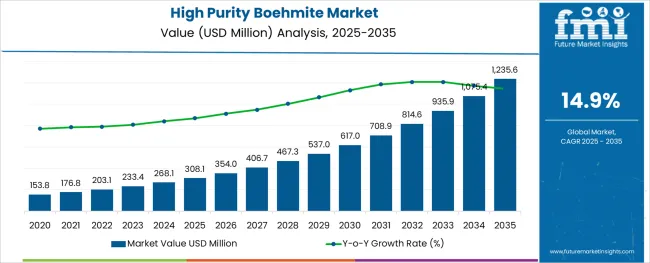
The high purity boehmite market is growing steadily, driven by the increasing demand for advanced materials in high-tech applications. The market has benefited from the rising use of boehmite in lithium-ion battery separators, where its high purity and unique properties improve battery safety and performance. Research highlights the critical role of high purity boehmite in enhancing thermal stability and mechanical strength of separators, contributing to longer battery life and safety standards.
Product innovations have introduced water dispersible formulations, facilitating easier integration into battery manufacturing processes. Industrial trends show growing investments in electric vehicle production and energy storage systems, which are expanding demand for advanced battery components.
The market outlook remains positive as sustainability and energy efficiency become key priorities. Segmental growth is expected to be led by the Above 99.9% purity grade, Water Dispersible product type, and the Li-Ion Battery Separator application.
The market is segmented by Purity, Product Type, and Application and region. By Purity, the market is divided into Above 99.9% and 99.0%-99.9%. In terms of Product Type, the market is classified into Water Dispersible, Acid Dispersible High, and Surface Modified High.
Based on Application, the market is segmented into Li-Ion Battery Separator, Electronic Ceramics, Flame Retardant, Catalysis, Surface Fractioning, Microcrystalline Ceramics, Refractory Materials, and Rheology Control. Regionally, the market is classified into North America, Latin America, Western Europe, Eastern Europe, Balkan & Baltic Countries, Russia & Belarus, Central Asia, East Asia, South Asia & Pacific, and the Middle East & Africa.
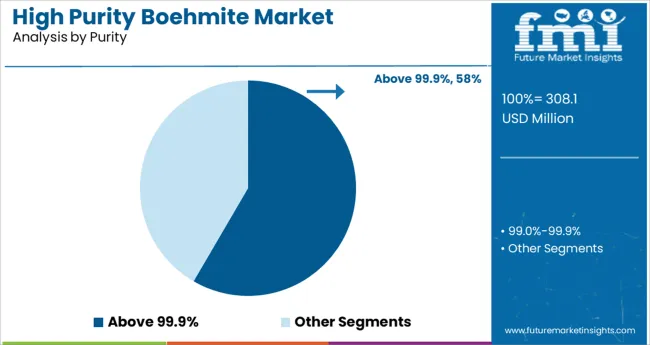
The Above 99.9% purity segment is projected to hold 58.4% of the high purity boehmite market revenue in 2025, positioning it as the dominant purity grade. This segment’s growth has been driven by stringent quality requirements in battery manufacturing and other high-tech industries. Materials with purity above 99.9% are preferred due to their minimal impurities, which can significantly impact battery performance and safety.
The demand for ultra-pure boehmite has increased with the expansion of electric vehicles and portable electronics requiring reliable and efficient battery components. Manufacturers focus on achieving high purity through advanced refining and synthesis methods, meeting the performance benchmarks set by battery developers.
As battery technologies continue to evolve, the need for consistently high purity boehmite is expected to sustain growth in this segment.
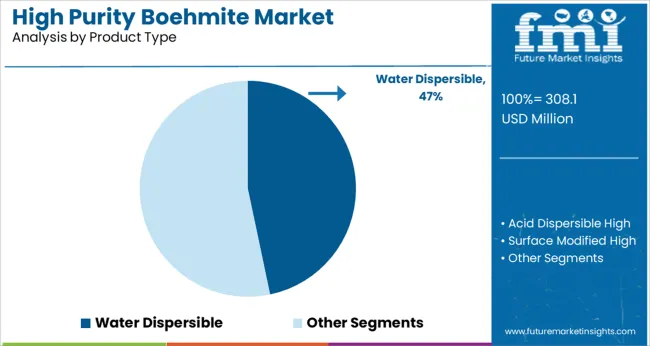
The Water Dispersible product type segment is expected to contribute 46.7% of the market revenue in 2025, making it the leading product type. Water dispersible boehmite offers advantages in processing and handling, especially in the formulation of battery separator coatings and ceramic applications.
The ability to disperse easily in aqueous systems facilitates uniform coating and enhances material performance. This segment’s growth has been supported by technological advances that improve dispersion stability and reduce agglomeration.
Production facilities have increasingly adopted water dispersible forms to streamline manufacturing workflows and meet environmental regulations by minimizing organic solvents. With increasing emphasis on efficient and environmentally friendly production processes, the water dispersible segment is anticipated to maintain its prominence in the market.
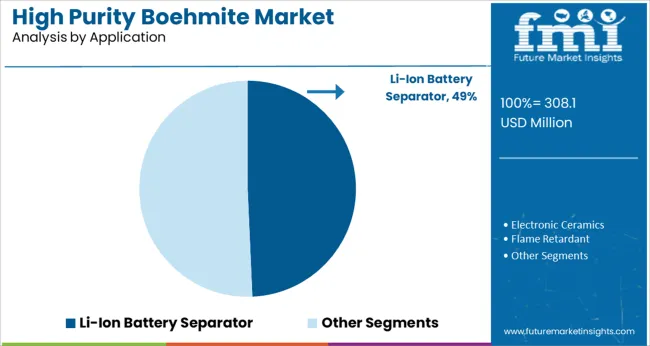
The Li-Ion Battery Separator application segment is projected to account for 49.3% of the high purity boehmite market revenue in 2025, establishing it as the primary application area. This segment’s growth has been fueled by the rapid expansion of the electric vehicle industry and the growing adoption of portable electronics.
High purity boehmite is valued for its role in enhancing the thermal and mechanical properties of battery separators, which are critical for battery safety and performance. The increasing demand for safer, longer-lasting batteries has led manufacturers to incorporate advanced materials like boehmite in separator membranes.
Moreover, regulatory emphasis on battery safety and environmental compliance has reinforced the need for improved separator materials. As the energy storage sector evolves, the Li-Ion Battery Separator segment is expected to sustain its market leadership.
Rising application of high purity boehmite across various industries such as electronics, automotive, and construction is a major factor providing impetus to the growth of high purity boehmite market.
With rising energy concerns and growing awareness among people, there has been a rapid shift towards renewable energy sources during the last few decades. This has created enormous demand for renewable energy storage technologies like lithium-ion batteries. Driven by this, sales of high purity boehmite are expected to increase at a stellar pace during the forecast period, as it is used as an integral part of Li-ion battery separator.
Similarly, inherent properties of high purity boehmite like consistency, high purity, dispersibility, and versatile nature are encouraging its adoption in various applications, thereby playing a key role in expanding the global high purity boehmite market size.
In addition to this, increasing demand for plastics in various end-use industries is expected to create significant demand for high purity boehmite during the forecast period. this can be attributed to the rising usage of high purity boehmite as a plastic additive.
Despite positive growth projections, there are certain factors that are likely to restrain the growth of high purity boehmite market. Some of these factors include high processing cost of high purity boehmite and availability of alternative materials.
As per FMI, Asia Pacific is expected to become the fastest growing and the largest market for high purity boehmite during the forecast period, owing to the rapidly growing automobile industry.
Over the years, there has been a rapid surge in the production and sales of electric vehicles across countries like China, South Korea, and India. This is emerging as a key factor in boosting the growth of high purity boehmite market in the Asia Pacific region.
Similarly, rising applications of high purity boehmite in electronics and construction industry will support the growth of the Asia Pacific high purity boehmite market during the forthcoming years.
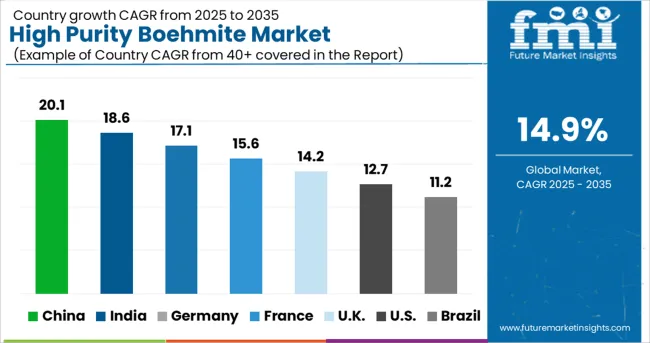
The high purity boehmite market in Europe is also projected to grow at a steady rate during the forecast period, owing to the increasing usage of high purity boehmite across various industries.
Demand is especially rising across countries like the UK, Germany, and France due to the increasing usage of high purity boehmite in lithium-ion batteries, rising popualrity of electric vehicles, and growing demand for advanced flame retardants.
Moreover, the region is well-equipped with advanced manufacturing facilities for lithium-ion batteries. This factor is set to further drive the demand for high purity boehmite in the Europe market during the forecast period.
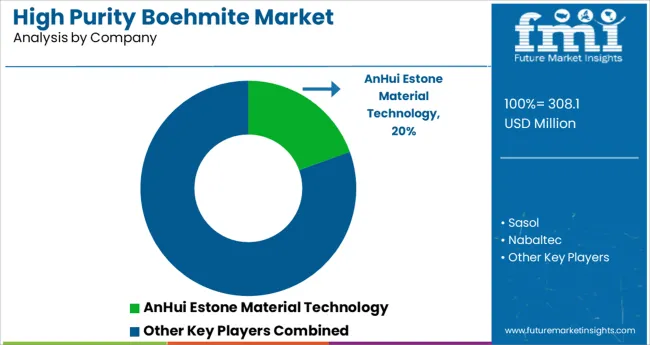
The global high purity boehmite market is moderately competitive. The key players have a well-defined presence in both developing and developed countries. Key players present in high purity boehmite market are Sasol, AnHui Estone Material Technology, TAIMEI Chemicals, Dequenne Chimie, Osang Group, Silkem, Xuancheng Jingrui New Materials, Tianjin Boyuan New Materials, Nabaltec, TOR Minerals, Kawai Lime Industry, among others.
These players are engaging in collaborations and strategic alliances so as to streamline the downstream flow of high purity boehmite products.
| Report Attribute | Details |
|---|---|
| Growth Rate (2025 to 20350 | 14.9% |
| Projected Market Size (2035) | USD 400 Million |
| Base Year for Estimation | 2024 |
| Historical Data | 2020 to 2024 |
| Forecast Period | 2025 to 2035 |
| Quantitative Units | Revenue in million, and CAGR from 2025 to 2035 |
| Report Coverage | Revenue Forecast, Volume Forecast, Company Ranking, Competitive Landscape, Growth Factors, Trends and Pricing Analysis |
| Segments Covered | Purity, Product Type, Application, Region |
| Countries Covered | North America (USA., Canada), Latin America (Mexico, Brazil), Western Europe (Germany, Italy, France, UK, Spain), Eastern Europe (Poland, Russia), China, India, SEAP (India, ASEAN, Australia & New Zealand), Japan, Middle East and Africa (GCC Countries, S. Africa, Northern Africa) |
| Key Companies Profiled | Sasol; AnHui Estone Material Technology; TAIMEI Chemicals; Dequenne Chimie; Osang Group; Silkem; Xuancheng Jingrui New Materials; Tianjin Boyuan New Materials; Nabaltec; TOR Minerals; Kawai Lime Industry |
| Customization | Available Upon Request |
The global high purity boehmite market is estimated to be valued at USD 308.1 million in 2025.
It is projected to reach USD 1,235.6 million by 2035.
The market is expected to grow at a 14.9% CAGR between 2025 and 2035.
The key product types are above 99.9% and 99.0%-99.9%.
water dispersible segment is expected to dominate with a 46.7% industry share in 2025.






Full Research Suite comprises of:
Market outlook & trends analysis
Interviews & case studies
Strategic recommendations
Vendor profiles & capabilities analysis
5-year forecasts
8 regions and 60+ country-level data splits
Market segment data splits
12 months of continuous data updates
DELIVERED AS:
PDF EXCEL ONLINE
High Reliability Oscillators Market Size and Share Forecast Outlook 2025 to 2035
High-performance Dual-core Processor Market Size and Share Forecast Outlook 2025 to 2035
High Performance Magnet Market Size and Share Forecast Outlook 2025 to 2035
High-frequency RF Evaluation Board Market Size and Share Forecast Outlook 2025 to 2035
High Viscosity Mixer Market Size and Share Forecast Outlook 2025 to 2035
High Voltage Ionising Air Gun Market Size and Share Forecast Outlook 2025 to 2035
High Voltage Equipment Market Forecast and Outlook 2025 to 2035
High Clear Film Market Size and Share Forecast Outlook 2025 to 2035
High Performance Random Packing Market Forecast Outlook 2025 to 2035
High Precision Microfluidic Pump Market Size and Share Forecast Outlook 2025 to 2035
High Performance Composites Market Forecast Outlook 2025 to 2035
High Performance Medical Plastic Market Forecast Outlook 2025 to 2035
High Temperature Heat Pump Dryers Market Size and Share Forecast Outlook 2025 to 2035
High Temperature Fiberglass Filter Media Market Size and Share Forecast Outlook 2025 to 2035
High Mast Lighting Market Forecast and Outlook 2025 to 2035
High-Protein Pudding Market Forecast and Outlook 2025 to 2035
High Voltage Ceramic Zinc Oxide Surge Arrester Market Size and Share Forecast Outlook 2025 to 2035
High-Power Microwave Source Market Size and Share Forecast Outlook 2025 to 2035
High Performance Epoxy Coating Market Size and Share Forecast Outlook 2025 to 2035
High Molecular Ammonium Polyphosphate Market Size and Share Forecast Outlook 2025 to 2035

Thank you!
You will receive an email from our Business Development Manager. Please be sure to check your SPAM/JUNK folder too.
Chat With
MaRIA